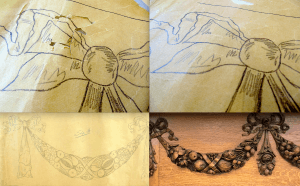Transparency can be tricky. Conserving UCL’s iconic buildings plans and drawings.
By Angela Warren-Thomas, on 29 June 2018
Written by Laurent Cruveillier on June 29, 2018
The College Plans, belonging to the Records Office Collections within UCL Special Collections, Archives and Records Department, are housed in part at the National Archives and in part at UCL. They are architectural plans and drawings of several landmarks of the UCL campus, such as the Cruciform, the Rockefeller Building of the “New” Chemistry building.

If most of these plans and drawings, dating from the end of the 19th and early 20th century are in stable condition, some show conservation pathologies that prevent their usage by students, scholars or the public, or would impede their handling for digitization and cataloguing purposes.
They present naturally occurring conditions in working documents, such as pin holes, folds, dirt and smudges, creases… but these objects are also often torn, cockled, warped, and bear historic repairs, many of which are made with pressure-sensitive adhesive tape that needs to be removed. Those conditions are worsened by the fact that most paper substrates are brittle, particularly the different kinds of tracing paper.
A conservation campaign was then launched to stabilize as many records as possible. The work started with surveying 485 items of the collection, and identifying the unstable ones.
The plans and drawings were prioritized according to their state and their relevance for the curators of the collection, and were treated according to a protocol aiming at stabilizing them with minimal intervention:
- Setting of tears using wheat starch paste
- Repairs and consolidation of regular paper objects using different thicknesses of remoistenable repair tissue prepared with wheat starch paste and methylcellulose.
Some of the tissue was toned with black acrylic paint for the repairs over black media on the recto of objects. - Repair and consolidation of tracing paper using remoistenable tissue prepared with Isinglass: a fine protein adhesive prepared using swim bladders of sturgeon fishes.
- Adhesive removal using poultices prepared with methylcellulose and ethanol, or heated spatulas and other solvents.
- Structural infills
- Photographic and written documentation:
Condition and treatment records - Housing in polyester pockets.
These interventions were carried out by paper conservators at UCL Special Collections Conservation Department, and also involved the participation of UAL – Camberwell College MA Conservation intern students, who were given the opportunity to add working collection objects treatments to their portfolios while learning and practicing different techniques, such as preparing Isinglass, removing adhesives or repairing tracing paper.
Priority was given to stability for handli
ng purposes, also respecting the nature of each substrate. For instance, repairs on tracing paper were done with extremely thin tissues to avoid being visible by transparency. Due to their aesthetical value, some objects were nevertheless given extra care, with the usage of toned tissues for repairs and infills. One plan with a large lacuna even received an infill digitally produced to minimize the visual impact of interrupted lines.
In the images, one can see the detail of record Ref. Nº ROC 86, a drawing for a decorative swag of the Board Room in the Rockefeller building before and after conservation. It was extremely rewarding for the conservators to discover that the ornament was still in place. As recommended in writing on the May 1907 document, the sculptor hadn’t “adhered” exactly to the drawing, but his execution of the motif still allowed super-imposing the final result with architect J. Carmichael’s vision.
 Close
Close


